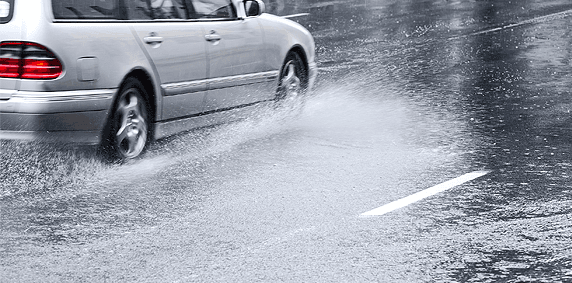Newsroom
ICBC: Drivers use caution in heavy rain and in case of flooding
October 27, 2022

With atmospheric rivers forecast in parts of the province this week, ICBC is reminding drivers to adjust their driving for the changing road conditions and be prepared in case of flooding.
Every year in B.C., crashes due to driving too fast for the conditions increase by 90% when comparing October to December (243 vs. 461 crashes) as the weather worsens.*
In bad weather, slow down, increase your following distance and allow extra travel time.
Tips
Prepare your vehicle for the weather conditions you may encounter. Check that your vehicle's headlights and taillights are in working order and keep wiper fluid topped up for clearer visibility. Make sure your tires are properly inflated, in good condition, and rated for the conditions you'll be driving in.
Weather is unpredictable and varies greatly at this time of year. Visit DriveBC.ca to check road conditions and possible road closures for your entire route.
An emergency can happen at any time so keep an emergency 'grab-and-go' kit in your vehicle to help you and your passengers stay safe.
If you find yourself on a road that's flooded, the best choice is to turn around if you can do so safely. If a road is marked as closed, don't continue.
Floodwater can quickly sweep away vehicles. The maximum water depth you can drive a standard car through is about 10 centimetres. Fifteen centimetres of water will reach the bottom of most passenger cars, causing loss of control and possible stalling and damage to the mechanical and electrical components of your vehicle. Thirty centimetres or a foot of water will float many vehicles.
Water can hide dips and potholes in the road as well as submerged trees or downed power lines. Without being able to see the road's surface, you may hit something and cause major damage to your vehicle (on top of possible flood damage).
Posted speed limits are for ideal road conditions. When driving in bad weather, slow down. Allow yourself at least twice the normal braking distance on wet or slippery roads.
Stay focused on the road and minimize distractions. Let phone calls go to voicemail and ignore your notifications while driving. If you have to take a call, pull over when it's safe to do so. Make sure you're focused on driving before re-entering traffic.
More tips on staying safe in a flood are available on icbc.com.
Regional statistics*:
Every year in the Lower Mainland, crashes due to driving too fast for the conditions increase by 50% when comparing October and December (114 vs. 171 crashes) as the weather worsens.
Every year on Vancouver Island, crashes due to driving too fast for the conditions increase by 52% when comparing October and December (50 vs. 76 crashes) as the weather worsens.
Every year in Southern Interior, crashes due to driving too fast for the conditions increase by 208% when comparing October and December (53 vs. 163 crashes) as the weather worsens.
Every year in northern B.C., crashes due to driving too fast for the conditions increase by 108% when comparing October and December (25 vs. 52 crashes) as the weather worsens.
*Police data based on five-year average (2016 to 2020).
